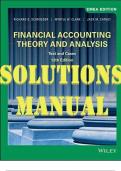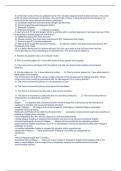, CHAPTER 1
Case l-1
a. The FASB had three primary goals in developing the Codification:
1. Simplify user access by codifying all authoritative US GAAP in one spot.
2. Ensure that the codified content accurately represented authoritative US GAAP as of
July1, 2009.
3. Create a codification research system that is up to date for the released results of
standard-setting activity.
b. The Codification is expected to improve accounting practice by:
1. Reducing the amount of time and effort required to solve an accounting research issue
2. Mitigating the risk of noncompliance through improved usability of the literature
3. Provide accurate information with real-time updates as Accounting Standards Updates
are released
4. Assisting the FASB with the research and convergence efforts.
c. The FASB ASC is composed of the following literature issued by various standard setters:
1. Financial Accounting Standards Board (FASB)
a. Statements (FAS)
b. Interpretations (FIN)
c. Technical Bulletins (FTB)
d. Staff Positions (FSP)
e. Staff Implementation Guides (Q&A)
f. Statement No. 138 Examples.
2. Emerging Issues Task Force (EITF)
a. Abstracts
b. Topic D.
3. Derivative Implementation Group (DIG) Issues
4. Accounting Principles Board (APB) Opinions
5. Accounting Research Bulletins (ARB)
6. Accounting Interpretations (AIN)
7. American Institute of Certified Public Accountants (AICPA)
a. Statements of Position (SOP)
b. Audit and Accounting Guides (AAG)—only incremental accounting guidance
c. Practice Bulletins (PB), including the Notices to Practitioners elevated to Practice
Bulletin status by Practice Bulletin 1
d. Technical Inquiry Service (TIS)—only for Software Revenue Recognition
Additionally, in an effort to increase the utility of the FASB ASC for public companies,
relevant portions of authoritative content issued by the SEC and selected SEC staff
interpretations and administrative guidance have been included for reference in the
Codification, such as:
1. Regulation S-X (SX)
2. Financial Reporting Releases (FRR)/Accounting Series Releases (ASR)
3. Interpretive Releases (IR)
4. SEC Staff guidance in:
a. Staff Accounting Bulletins (SAB)
b. EITF Topic D and SEC Staff Observer co mments
1
,d. The FASB ASC contains all current authoritative accounting literature. However, if the
guidance for a particular transaction or event is not specified within it, the first source to
consider is accounting principles for similar transactions or events within a source of
authoritative GAAP. If no similar transactions are discovered, nonauthoritative guidance from
other sources may be considered. Accounting and financial reporting practices not included in
the Codification are nonauthoritative. Sources of nonauthoritative accounting guidance and
literature include, for example, the following:
1. Practices that are widely recognized and prevalent either generally or in the industry
2. FASB Concepts Statements
3. American Institute of Certified Public Accountants (AICPA) Issues Papers
4. International Financial Reporting Standards of the International Accounting Standards
Board Pronouncements of professional associations or regulatory agencies
5. Technical Information Service Inquiries and Replies included in AICPA Technical
Practice Aids
6. Accounting textbooks, handbooks, and articles
Case 1-2
a. Inclusion or omission of information that materially affects net income harms particular
stakeholders. Accountants must recognize that their decision to implement (or delay)
reporting requirements will have immediate consequences for some stakeholders.
b. Yes. Because the FASB standard results in a fairer presentation, it should be implemented as
soon as possible--regardless of its impact on net income.
c. The accountant's responsibility is to provide financial statements that present fairly the
financial condition of the company. By advocating early implementation, Hoger fulfills this
task.
d. Potential lenders and investors, who read the financial statement and rely on its fair
representation of the financial condition of the company, have the most to gain by early
implementation. A stockholder who is considering the sale of stock may be harmed by early
implementation that lowers net income (and may lower the value of the stock).
Case 1-3
a. CAP. The Committee on Accounting Procedure, CAP, which was in existence from 1939 to
1959, was a natural outgrowth of AICPA (then AIA) committees, which were in existence
during the period 1933 to 1938. The committee was formed in direct response to the criticism
received by the accounting profession during the financial crisis of 1929 and the years
thereafter. The authorization to issue pronouncements on matters of accounting principles
and procedures was based on the belief that the AICPA had the responsibility to establish
practices that would become generally accepted by the profession and by corporate
management.
As a general rule, the CAP directed its attention, almost entirely, to resolving specific
accounting problems and topics rather than to the development of generally accepted
accounting principles. The committee voted on the acceptance of specific Accounting
Research Bulletins published by the committee. A two-thirds majority was required to issue a
particular research bulletin. The CAP did not have the authority to require acceptance of the
issued bulletins by the general membership of the AICPA, but rather received its authority
only upon general acceptance of the pronouncement by the members. That is, the bulletins set
forth normative accounting procedures that "should be" followed by the accounting
profession, but were not "required" to be followed.
It was not until well after the demise of the CAP, in 1964, that the Council of the AICPA
adopted recommendations that departures from effective CAP Bulletins should be disclosed in
financial statements or in audit reports of members of the AICPA. The demise of the CAP
2
, could probably be traced by four distinct factors: (1) the narrow nature of the subjects
covered by the bulletins issued by the CAP, (2) the lack of any theoretical groundwork in
establishing the procedures presented in the bulletins, (3) the lack of any real authority by the
CAP in prescribing adherence the procedures described by the bulletins, and (4) the lack of
any formal representation on the CAP of interest groups such as corporate managers,
governmental agencies, and security analysts.
APB. The objectives of the APB were formulated mainly to correct the deficiencies of the
CAP as described above. The APB was thus charged with the responsibility of developing
written expression of generally accepted accounting principles through consideration of the
research done by other members of the AICPA in preparing Accounting Research Studies.
The committee was in turn given substantial authoritative standing in that all opinions of the
APB were to constitute substantial authoritative support for generally accepted accounting
principles. If an individual member of the AICPA decided that a principle of procedure
outside of the official pronouncements of the APB had substantial authoritative support, the
member had to disclose the departure from the official APB opinion in the financial
statements of the firm in question.
The membership of the committee comprising the APB was also extended to include
representation from industry, government, and academe. The opinions were also designed to
include minority dissents by members of the board. Exposure drafts of the proposed opinions
were readily distributed.
The demise of the APB occurred primarily because the purposes for which it was created
were not being accomplished. Broad generally accepted accounting principles were not being
developed. The research studies supposedly being undertaken in support of subsequent
opinions to be expressed by the APB were often ignored. The committee in essence became a
simple extension of the original CAP in that only very specific problem areas were being
addressed. Interest groups outside of the accounting profession questioned the
appropriateness and desirability of having the AICPA directly responsible for the
establishment of GAAP. Politicization of the establishment of GAAP had become a reality
because of the far-reaching effects involved in the questions being resolved.
FASB. The formal organization of the FASB represents an attempt to vest the responsibility
of establishing GAAP in an organization representing the diverse interest groups affected by
the use of GAAP. The FASB is independent of the AICPA. It is independent, in fact, of any
private or governmental organization. Individual CPAs, firms of CPAs, accounting educators,
and representatives of private industry will now have an opportunity to make known their
views to the FASB through their membership on the Board. Independence is facilitated
through the funding of the organization and payment of the members of the Board. Full-time
members are paid by the organization and the organization itself is funded solely through
contributions. Thus, no one interest group has a vested interest in the FASB.
Conclusion. The evolution of the current FASB certainly does represent "increasing
politicization of accounting standard setting." Many of the efforts extended by the AICPA
can be directly attributed to the desire to satisfy the interests of many groups within our
society. The FASB represents, perhaps, just another step in this evolutionary process.
b. Arguments for politicization of the accounting rule-making process:
1. Accounting depends in large part on public confidence for its success.
Consequently, the critical issues are not solely technical, so all those having a bona
fide interest in the output of accounting should have some influence on that output.
2. There are numerous conflicts between the various interest groups. In the face of this,
compromise is necessary, particularly since the critical issues in accounting are value
judgments, not the type which are solvable, as we have traditionally assumed, using
deterministic models. Only in this way (reasonable compromise) will the financial
community have confidence in the fairness and objectivity of accounting rule
making.
3





